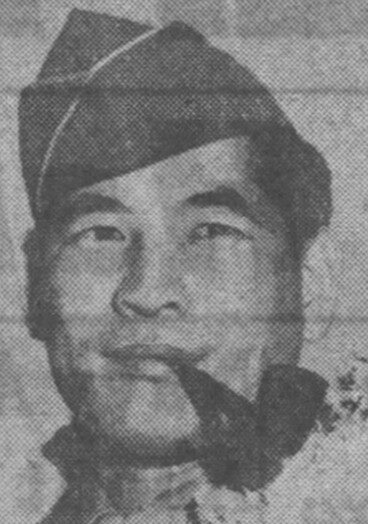Soldier Story: Wilbert Hiroshi Kishinami
Soldier Story

Wilbert Hiroshi Kishinami
Corporal
442nd Regimental Combat Team
Military Intelligence Service
Wilbert Hiroshi Kishinami was born on November 10, 1912, in Waialua, Oahu, Territory of Hawaii. He was the eldest child of Kiemon and Kiso (Yasuda) Kishinami. His siblings were: brothers Lawrence Masami, Edward Seichi, and Robert Noboru; and sister Gladys Kimiko.
Kiemon and Kiso arrived as a married couple in Honolulu on December 23, 1906, from Fukushima Prefecture, Japan. They worked on the Waialua Sugar Plantation. By 1930, Kiemon was a retail grocer. Wilbert attended Waialua School, completing 8th grade in 1928. He also attended Taishio Japanese School near Haleiwa, graduating from 9th grade in 1928. He then attended Leilehua High School in Wahiawa. He was active in the Rural YMCA swimming team. In 1931, he was one of the organizers of the Haleiwa Hi-Y Club and its treasurer. Kishinami was president in 1937 of the Haleiwa Baseball Team of the Oahu Japanese Senior League.
Wilbert married Edythe Asako Yamamoto on May 19, 1939. She was the daughter of Ichiro and Tayo Yamamoto of Waialua and the village of Takashino, Atsusa District, Yamaguchi Prefecture, Japan. The newlyweds settled at New Ranch Camp No. 1, where Wilbert was employed as a clerk in the plantation office and Edythe worked at the Schofield Barracks Post Exchange. They were active in the Waialua Civic Club. Wilbert signed his draft registration card on October 26, 1940, Local Board No. 11, Waialua Fire Station. Edythe was his point of contact and their address was P.O. Box 525, Waialua. He was 5’7” tall and weighed 160 pounds.
On March 23, 1943, Wilbert enlisted in the U.S. Army in Honolulu and was sent with the other 442nd RCT volunteers to the “tent city” at Schofield Barracks known as Boomtown. On March 28, they were given an aloha farewell ceremony by the community at Iolani Palace. The new soldiers sailed on the S.S. Lurline on April 4 for Oakland, California. The men were then sent by train to Camp Shelby, Mississippi.
Our research did not reveal the battalion and company to which Private Kishinami was assigned after arrival at Camp Shelby. After basic, unit, and combat training and field maneuvers, he was among the 442nd soldiers who – due to their Japanese language abilities – were transferred to the Military Intelligence Service (MIS) for language training. Most of these soldiers wanted to remain in the 442nd, but were transferred nonetheless.
Kishinami was in the second class of 1944 at the MIS Language School at Camp Savage, Minnesota, just south of Minneapolis. After graduation, he was assigned to the Office of Strategic Service (OSS), Detachment 101, which was the first American unit ever assembled to conduct guerrilla warfare, espionage, propaganda, sabotage, and escape and evasion behind enemy lines in the China-Burma-India (CBI) Theater, where Kishinami served.
After the war in the Pacific ended on September 2, 1945, Corporal Kishinami arrived back in the US, where he next traveled on the USAT Aconcagua from San Francisco, California, arriving at 8:00 a.m. at Pier 26 in Honolulu on December 17, 1945. He was trucked with the other approximately 500 returning veterans to Fort Kamehameha for processing. He was discharged from the Army on December 27, 1945.
For his military service in World War II, Corporal Kishinami earned the: Bronze Star Medal, Good Conduct Medal, American Campaign Medal, Asiatic-Pacific Campaign Medal, and World War II Victory Medal, and Combat Infantryman Badge. He was awarded the Presidential Unit Citation on January 17, 1956, with other members of Detachment 101. He was posthumously awarded the Congressional Gold Medal on October 5, 2010, along with the other veterans of the 100th/442nd Regimental Combat Team and MIS. Conferred by the U.S. Congress, the award states: “The United States remains forever indebted to the bravery, valor, and dedication to country these men faced while fighting a 2-fronted battle of discrimination at home and fascism abroad. Their commitment and sacrifice demonstrates a highly uncommon and commendable sense of patriotism and honor.ˮ
By 1950, Wilbert and Edythe were living at New Ranch Camp, Waialua, where he was employed as administrative assistant to the civil engineer on the plantation and Edythe was a secretary at the sugar mill. Her widowed mother Tayo Yamamoto lived with them. That year, Wilbert became president of the Waialua Y’s Men’s Club. They raised one son and remained in Waialua. Over the years, the couple was active in Waialua civic activities, and Wilbert was a member of the Lions Club and founder of the Waialua Federal Credit Union. He worked at the Waialua Agriculture Company Ltd. until his retirement.
Wilbert Hiroshi Kishinami died at the age of 91 on June 7, 2004. Survivors included: his wife Edythe, one son, two grandsons, brothers Edward Seichi and Robert Noboru, and sister Gladys (Mrs. Daniel Eiji) Takehara. He was inurned at the National Memorial Cemetery of the Pacific at Punchbowl, Court 6A, Row 400, Site 475. “Until We Meet in Heaven” was inscribed on his niche. His wife Edythe died on August 10, 2008, and was inurned with her husband.
His brother Robert Noboru Kishinami served in the 442nd RCT, 2nd Battalion, G Company. Brother Edward Seichi Kishinami served in the 1399th Engineer Construction Battalion, Company B.
Researched and written by the Sons & Daughters of the 442nd RCT in 2025.